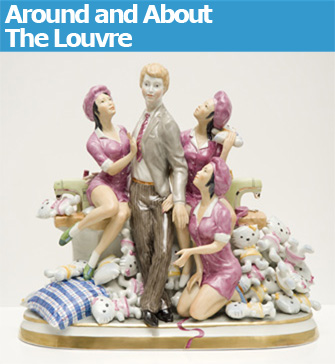 |
|
“Business Man Toy Factory” (2008) byAES+F, from the Louvre’s “Counterpoint” exhibition, |
The other day I spent six hours dashing around every wing of the Louvre for a work assignment. I don’t recommend such an exhausting marathon to anyone else, but it was a joy to discover …
 |
|
“Business Man Toy Factory” (2008) byAES+F, from the Louvre’s “Counterpoint” exhibition,
|
The other day I spent six hours dashing around every wing of the Louvre for a work assignment. I don’t recommend such an exhausting marathon to anyone else, but it was a joy to discover parts of this enormous, confusingly laid-out museum that I had never seen before and to catch glimpses of favorite or unknown works. I made mental notes to return for a closer look at the incredible Egyptian rooms, which I had never really explored before, and to the French paintings section, rich in stunning works by the likes of Philippe de Champaigne and Camille Corot.
Paris has many, many museums with rich permanent collections that are often nearly empty of visitors while the temporary exhibitions get all the attention: the Petit Palais, the Musée d’Art Moderne de la Ville de Paris, the Centre Pompidou, the Musée de la Marine, the Musée des Arts et Métiers, to mention just a few (click here for a full list of Paris museums).
During my full-immersion visit to the Louvre, I stumbled across two temporary exhibitions. Like many art institutions these days – most controversially Versailles, where the works of Japanese artist Takashi Murakami are on show until December 12 (only in France department: Prince Sixte-Henri de Bourbon-Parme, a descendant of Louis XIV, has filed a lawsuit complaining of an “attack on the respect due to the work of Louis XIV”) – the Louvre now welcomes contemporary art in hopes of staying in tune with the times and attracting younger visitors.
The show called “Counterpoint: Russian Contemporary Art, From Icon to Avant-Garde by Way of the Museum” is a treat. It is displayed in the excavated and beautifully restored foundations of the 12-century fortress the Louvre was built upon, providing a dimly lit, mysterious setting for some wonderful works of art.
Valery Koshlyakov’s impressive “Le Louvre” is a monumental image of the museum, painted in blues, grays and whites on sheets of cardboard pieced together. A video by Vadim Zakharov, projected on the stone walls, has realistic-looking flames lapping around the bottom and shooting up the side of the castle keep.
That marvelous duo of conceptual artists, Ilya and Emilia Kabakov, are well represented by seven models of their wry pieces, such as “Springboard for Icarus,” (2003), which is just that, a giant springboard to give the ill-fated Icarus extra propulsion. (In the city of Bordeaux you can see one of the Kabakov’s projects actually built: the “Maison des Personnages,” a real house through each window of which you can see the story of a different person’s life.)
Another of my favorite pieces was Olga Chernysheva’s “Russian Museum,” a film in which the visitors and works of art seem to merge in reflections on glass, accompanied by her lovely drawings. Alexander Brodsky has contributed two pieces, one of which, “Rotunda,” is set up in the Tuileries Garden.
The other temporary show I ran into was “Faces and Bodies,” an exhibition of works chosen from the Louvre’s collection by filmmaker and theater and opera director Patrice Chéreau, who has taken many of the museum’s best paintings and hung them next to photographs by Nan Goldin. The reasoning behind these juxtapositions is not always clear, except for a few nice correspondences between the lighting in some of the paintings and photos, but it is pure pleasure to see so many masterpieces in one room.
In more news from the Louvre, the museum is trying to raise €1 million toward the purchase of “The Three Graces” (1531), by Lucas Cranach the Elder, a gorgeous work that has never been seen by the public and is being sold for €4 million. If it can raise the money, the museum will exercise its right to first claim on the work so that it will not leave France. Click here to see the painting or make a donation.
Musée du Louvre: Sully Wing. Métro: Palais-Royal-Musée du Louvre. Open Wednesday-Monday, 9am-6pm (until 10pm on Wednesday and Friday). Closed Tuesday. Admission: ![]() €9.50 (€6 after 6pm on Wednesday and Friday). www.louvre.fr
€9.50 (€6 after 6pm on Wednesday and Friday). www.louvre.fr
Support Paris Update by ordering books from Paris Update’s Amazon store at no extra cost. Click on your preferred Amazon location: U.K., France, U.S.
Reader Reaction: Click here to respond to this article (your response may be published on this page and is subject to editing).
More reviews of Paris art shows.
© 2010 Paris Update
Favorite